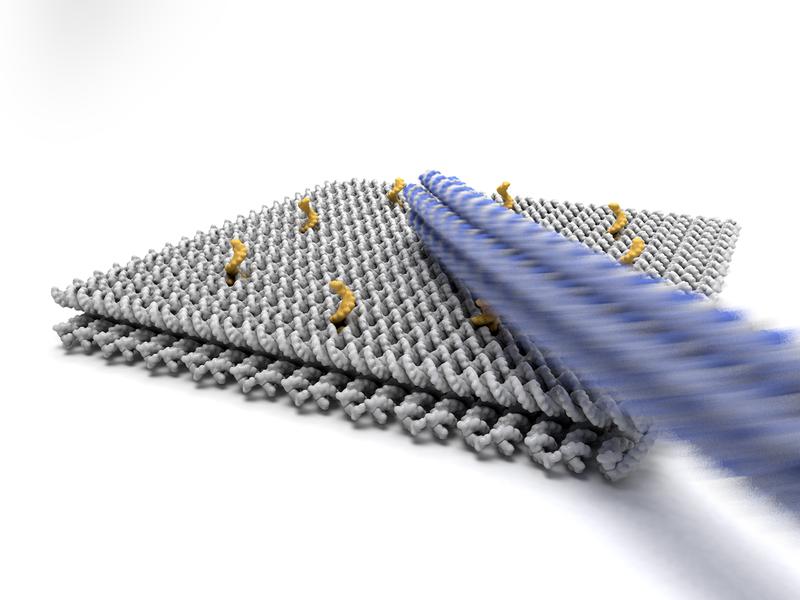
Electrical Fields Propel Nano-Machines at Breakneck Speed

Electric fields drive the rotating nano-crane – 100,000 times faster than previous methods.
Enzo Kopperger / TUM
Up and down, up and down. The points of light alternate back and forth in lockstep. They are produced by glowing molecules affixed to the ends of tiny robot arms. Prof. Friedrich Simmel observes the movement of the nanomachines on the monitor of a fluorescence microscope. A simple mouse click is all it takes for the points of light to move in another direction.
“By applying electric fields, we can arbitrarily rotate the arms in a plane,” explains the head of the Chair of Physics of Synthetic Biological Systems at TU Munich. His team has for the first time managed to control nanobots electrically and has at the same time set a record: The new technique is 100 000 times faster than all previous methods.
DNA-Origami robots for the manufacturing plants of tomorrow
Scientists around the world are working on new technologies for the nanofactories of the future. They hope these will one day be used to analyse biochemical samples or produce active medical agents. The required miniature machines can already be produced cost-effectively using the DNA-origami technique.
One reason these molecular machines have not been deployed on a large scale to date is that they are too slow. The building blocks are activated with enzymes, strands of DNA or light to then perform specific tasks, for example to gather and transport molecules.
However, traditional nanobots take minutes to carry out these actions, sometimes even hours. Therefore, efficient molecular assembly lines cannot, for all practical intents and purposes, be implemented using these methodologies.
Electronic speed boost
“Building up a nanotechnological assembly line calls for a different kind of propulsion technology. We came up with the idea of dropping biochemical nanomachine switching completely in favour of the interactions between DNA structures and electric fields,” explains TUM researcher Simmel, who is also the co-coordinator of the Excellence Cluster Nanosystems Initiative Munich (NIM).
The principle behind the propulsion technology is simple: DNA molecules have negative charges. The biomolecules can thus be moved by applying electric fields. Theoretically, this should allow nanobots made of DNA to be steered using electrical fields.
Robotic movement under the microscope
To determine whether and how fast the robot arms would line up with an electric field, the researchers affixed several million nanobot arms to a glass substrate and placed this into a sample holder with electrical contacts designed specifically for the purpose.
Each of the miniature machines produced by the lead author Enzo Kopperger comprises a 400 nanometer arm attached to a rigid 55 by 55 nanometer base plate with a flexible joint made of unpaired bases. This construction ensures that the arms can rotate arbitrarily in the horizontal plane.
In collaboration with fluorescence specialists headed by Prof. Don C. Lamb of the Ludwig Maximillians University Munich, the researchers marked the tips of the robot arms using dye molecules. They observed their motion using a fluorescence microscope. They then changed the direction of the electric field. This allowed the researchers to arbitrarily alter the orientation of the arms and control the locomotion process.
“The experiment demonstrated that molecular machines can be moved, and thus also driven electrically,” says Simmel. “Thanks to the electronic control process, we can now initiate movements on a millisecond time scale and are thus 100 000 times faster than with previously used biochemical approaches.”
On the road to a nanofactory
The new control technology is suited not only for moving around dye molecules and nanoparticles. The arms of the miniature robots can also apply force to molecules. These interactions can be utilized for diagnostics and in pharmaceutical development, emphasizes Simmel. “Nanobots are small and economical. Millions of them could work in parallel to look for specific substances in samples or to synthesize complex molecules – not unlike an assembly line.
The research was funded by the Collaborative Research Program SFB 1032 “Nanoagents” by the German Research Foundation and the International Graduate School of Science and Engineering at TUM, as well as the Center for Nano Science and the BioImaging Network at the Ludwig Maximillians University in Munich.
Publication:
E. Kopperger, J. List, S. Madhira, F. Rothfischer, D. C. Lamb, F. C. Simmel,
A self-assembled nanoscale robotic arm controlled by electric fields,
Science, January 19, 2018.
Contact:
Prof. Dr. Friedrich C. Simmel
Technical University of Munich
Physics of Synthetic Biological Systems
Am Coulombwall 4a, 85748 Garching, Germany
Tel.: +49 89 289 11610 – E-mail: simmel@tum.de
http://www.e14.ph.tum.de/en/home/ Homepage of the research group
http://science.sciencemag.org/content/359/6373/296/tab-figures-data Videos (at the bottom of the page)
https://www.tum.de/die-tum/aktuelles/pressemitteilungen/detail/article/34360/ DNA-origami mass production
https://www.tum.de/nc/en/about-tum/news/press-releases/detail/article/34408/ Press release on the homepage of the Technical University of Munich









![[Figure 1] Schematic of next-generation CNT-PANI composite fiber supercapacitor and comparison graph with recent results](https://www.innovations-report.com/wp-content/uploads/2025/05/KIST_leads_next-generation_energy_storage_technolo_1746783279-e1746784635527-362x245.jpg)


